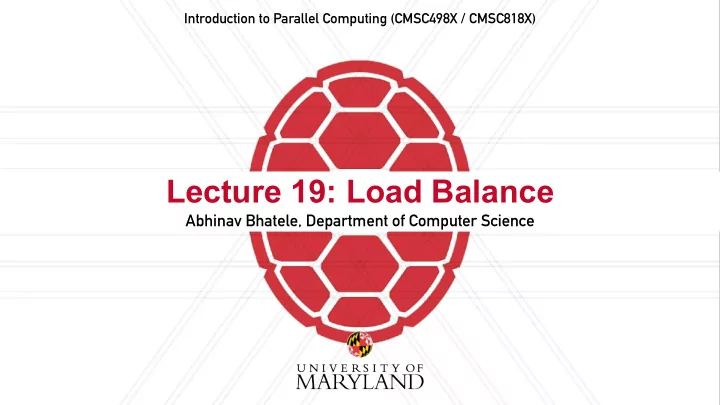

Introduction to Parallel Computing (CMSC498X / CMSC818X) Lecture 19: Load Balance Abhinav Bhatele, Department of Computer Science
Announcements • Quiz 2: Nov 12 • Quiz 3: Dec 3 Abhinav Bhatele (CMSC498X/CMSC818X) LIVE RECORDING 2
Performance issues • Algorithmic overhead • Speculative loss • Critical paths • Bottlenecks • Sequential performance issues • Load imbalance • Communication performance Abhinav Bhatele (CMSC498X/CMSC818X) LIVE RECORDING 3
Load imbalance Abhinav Bhatele (CMSC498X/CMSC818X) LIVE RECORDING 4
Load imbalance • Definition: unequal amounts of “work” assigned to different processes • Work could be computation or communication or both Abhinav Bhatele (CMSC498X/CMSC818X) LIVE RECORDING 4
Load imbalance • Definition: unequal amounts of “work” assigned to different processes • Work could be computation or communication or both • Why is load imbalance bad? • Overloaded processes can slow down everyone Abhinav Bhatele (CMSC498X/CMSC818X) LIVE RECORDING 4
Load imbalance • Definition: unequal amounts of “work” assigned to different processes • Work could be computation or communication or both • Why is load imbalance bad? • Overloaded processes can slow down everyone Load imbalance = max _ load avg _ load Abhinav Bhatele (CMSC498X/CMSC818X) LIVE RECORDING 4
Load balancing • The process of balancing load across threads, processes etc. • Goal: to bring the maximum load close to average as much as possible • Determine if load balancing is needed • Determine when to load balance • Determine what information to gather/use for load balancing Abhinav Bhatele (CMSC498X/CMSC818X) LIVE RECORDING 5
Is load balancing needed? • Need the distribution of load (“work”) across processes • Collect empirical information using performance tools • Developer knowledge • Analytical models of load distribution Abhinav Bhatele (CMSC498X/CMSC818X) LIVE RECORDING 6
When to load balance? • Initial work distribution or static load balancing • At program startup • Or sometimes in a separate run to determine load distribution • Dynamic load balancing: does load distribution evolve over time? • During program execution Abhinav Bhatele (CMSC498X/CMSC818X) LIVE RECORDING 7
Information gathering for load balancing • Centralized load balancing • Gather all load information at one process — global view of data • Distributed load balancing • Every process only knows the load of a constant number of “neighbors” • Hybrid or hierarchical load balancing Abhinav Bhatele (CMSC498X/CMSC818X) LIVE RECORDING 8
What information is used for load balancing • Computational load • Possibly, communication load (number/sizes of messages) • Communication graph Abhinav Bhatele (CMSC498X/CMSC818X) LIVE RECORDING 9
Load balancing algorithms • Input: Amount of work ( n i ) assigned to each process p i • Output: New assignments of work units to different processes • Goals: • Bring maximum load close to average • Minimize the amount of load migration • Secondary goals: • Balance (possibly reduce) communication load • Keep the time for doing load balancing short Abhinav Bhatele (CMSC498X/CMSC818X) LIVE RECORDING 10
Examples of static load balancing • Decomposition of 2D Stencil • Using orthogonal recursive bisection (ORB) http://datagenetics.com/blog/march22013/ https://en.wikipedia.org/wiki/Z-order_curve Abhinav Bhatele (CMSC498X/CMSC818X) LIVE RECORDING 11
Examples of static load balancing • Decomposition of 2D Stencil • Using orthogonal recursive bisection (ORB) http://datagenetics.com/blog/march22013/ https://en.wikipedia.org/wiki/Z-order_curve Abhinav Bhatele (CMSC498X/CMSC818X) LIVE RECORDING 11
Examples of static load balancing • Decomposition of 2D Stencil • Using orthogonal recursive bisection (ORB) ORB Space- filling curves http://datagenetics.com/blog/march22013/ http://charm.cs.uiuc.edu/workshops/charmWorkshop2011/slides/CharmWorkshop2011_apps_ChaNGa.pdf https://en.wikipedia.org/wiki/Z-order_curve Abhinav Bhatele (CMSC498X/CMSC818X) LIVE RECORDING 11
Simple greedy strategy Abhinav Bhatele (CMSC498X/CMSC818X) LIVE RECORDING 12
Other considerations • Communication-aware load balancing • Network topology-aware load balancing Abhinav Bhatele (CMSC498X/CMSC818X) LIVE RECORDING 13
Hierarchical load balancing Token Object 0 Refinement load balancing Load Data 0 1024 63488 64512 Load Data 0 1023 1024 2047 63488 64511 64512 65535 Greedy load balancing Abhinav Bhatele (CMSC498X/CMSC818X) LIVE RECORDING 14
Abhinav Bhatele 5218 Brendan Iribe Center (IRB) / College Park, MD 20742 phone: 301.405.4507 / e-mail: bhatele@cs.umd.edu
Recommend
More recommend